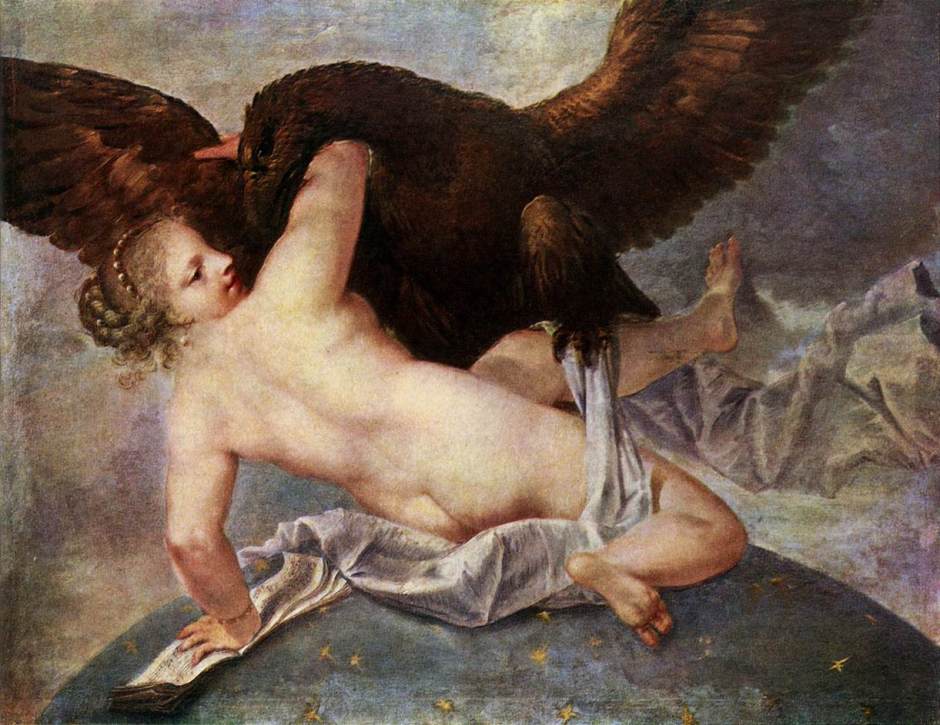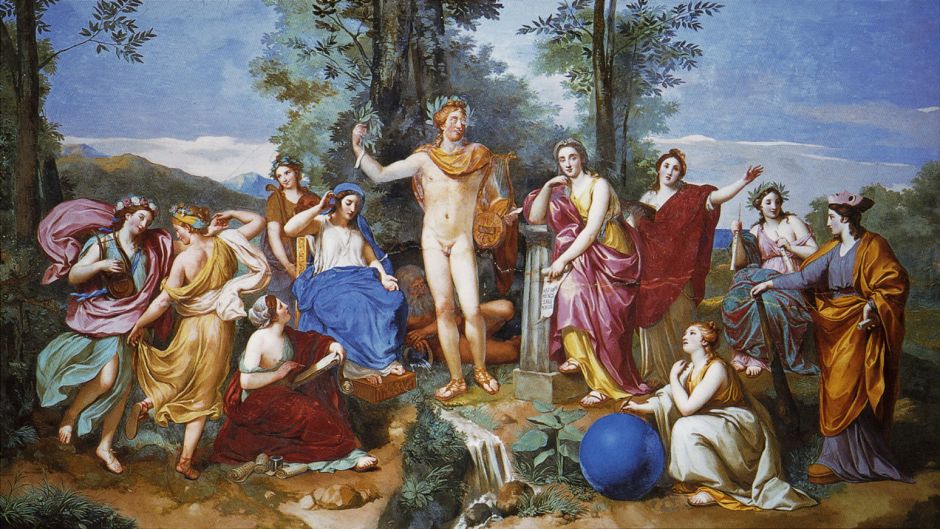Many classical Greek and Roman artists were generous enough to label the figures in their paintings. Where we have lost the context that their original owners might have enjoyed, these labels are often the only good clues as to what the painting is about. In the beautiful mosaic below, the crucial letters identify the figure of Mnemosyne, apparently a fairly undistinguished-looking woman sat with a group who could be Muses, perhaps.

Mnemosyne, you will probably recognise, is the personification of memory, and mother of the Muses. Although we tend to think of nine Muses, the count only stabilised at that number in relatively late classical times, and was always prone to adjustment. The mosaic, from Antioch in Turkey, is one of the few good depictions in art of Mnemosyne, who is a rather indistinct character who never really achieved particular fame in anything, apart from her relationship with Zeus/Jupiter, and her talented daughters.
The best-accepted account of the origins of the classical Greek gods portrays them as descendants of, and replacements for, the Titans. The daughter of the Titans Uranus, proto-god of the sky, and Gaia, proto-goddess of the earth, Mnemosyne acted as the head and controller of her daughters, the Muses, and gave kings and poets their authoritative powers of speech.
Her daughters were conceived with Zeus, who led the overthrow of the Titans and established himself as the king of the gods who succeeded them. To achieve a nine-fold pregnancy, Zeus slept with Mnemosyne on nine consecutive nights. Even in the thousands of lines of poetry which Ovid wrote in his Metamorphoses, Mnemosyne only warrants mention in a single line, as one of the subjects of Arachne’s wonderful weavings, and there for her relationship with Zeus.

Marco Liberi’s Jupiter and Mnemosyne (c 1670) shows Zeus, in his usual guise as a dark brown eagle, forcing himself upon a naked Mnemosyne, who is not given any marks of distinction. Additionally, most accounts (including Ovid’s) make it clear that Zeus disguised himself as a shepherd for his liaison with Mnemosyne.

Jacob de Wit’s Jupiter and Mnemosyne from 1727 shows this more faithfully: the eagle, complete with a small stock of thunderbolts, now keeping station above the couple, who have the (im)moral support of three cupids and a spectating couple in the trees at the right.

The most thorough account of Mnemosyne before the nineteenth century is that of Anton Raphael Mengs. This is his Parnassus, a highly-finished sketch for a fresco shown below, which he painted in about 1760. Standing in the centre is not Zeus, the father of the Muses, but Apollo, complete with his lyre and laurel wreaths, used to crown those who became accomplished thanks to the Muses.
To the left of Apollo is Mnemosyne herself, with a dark blue skirt, who is pointing towards a small spring in front of Apollo’s feet. The other women are Mnemosyne’s daughters, each with symbols to identify them.
The puzzling figure is lurking in the shadows behind Apollo’s legs: possibly a river god, responsible for the origin of the water. There is also an Orphic tradition in which the River Mnemosyne is the source of water to bring inspiration, and this is perhaps an allusion to that rather obscure sub-narrative.

This is the finished fresco, known as Apollo, Mnemosyne, and the Nine Muses which Mengs painted in 1761 in the Villa Albani-Torlonia in Rome.

In more modern times, Mnemosyne has been used as the personification of memory, here with a lyre in a war memorial in New Zealand.
But for me the most interesting of the few paintings of Mnemosyne is that by Dante Gabriel Rossetti.

His Mnemosyne, also known as The Lamp of Memory, or Ricordanza (c 1876-1881), took around five years to complete. It is a reworking of an earlier painting, Venus Astarte, for which his model was Jane Morris (née Burden), the wife of the designer, artist and poet William Morris (1834-1896). At the time, Rossetti saw Jane Morris as his muse, and was quite infatuated with her.
Rossetti inscribed two lines of his own poetry (not known from any other source) on the frame:
Thou fill’st from the winged chalice of the soul
Thy lamp, O Memory, fire-winged to its goal.
Whereas Jane Morris elsewhere usually has a sultry beauty, here she stares, her face blank and empty of emotion. In her right hand, she holds what is intended to be a small light, and in her left she holds an ornate oil lantern. By that is a single pansy flower, a symbol of remembrance, and a sprig of yew with a couple of berries – an ancient associate for protection against evil, and for connecting to the past.
Rossetti dated the painting 1881, the year that he sold it. The following April, he was dead, his body destroyed by his addiction to chloral, and the whisky he drank with it.
Reference

